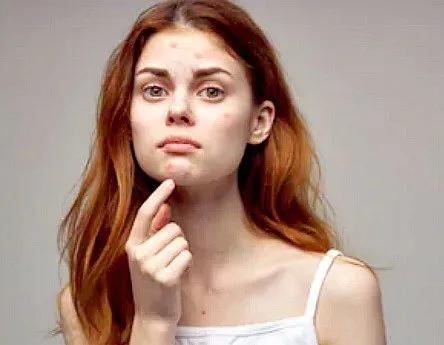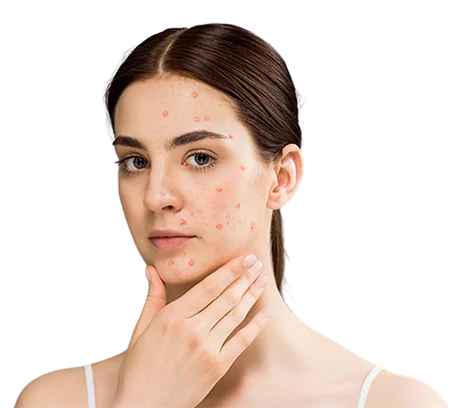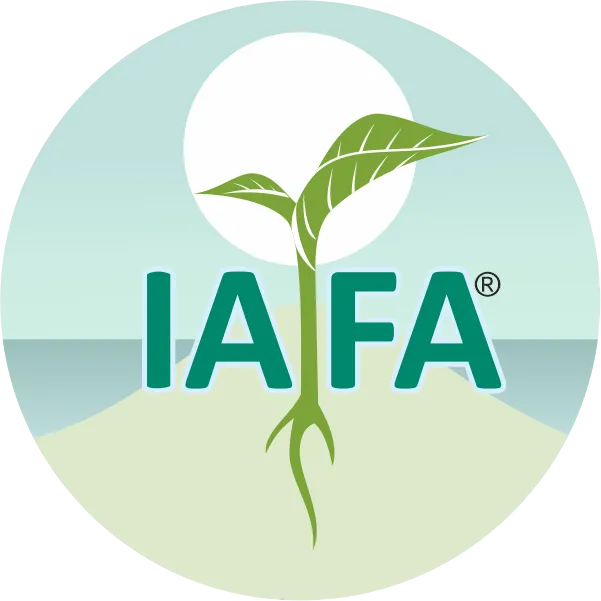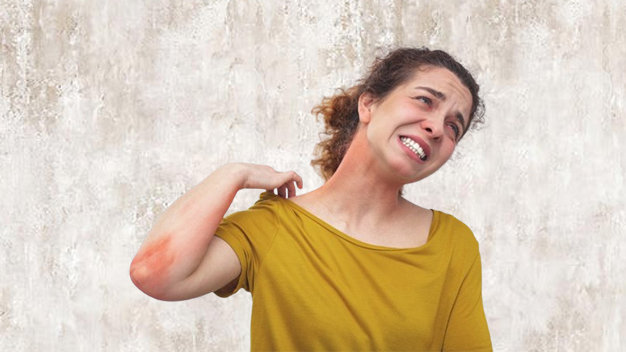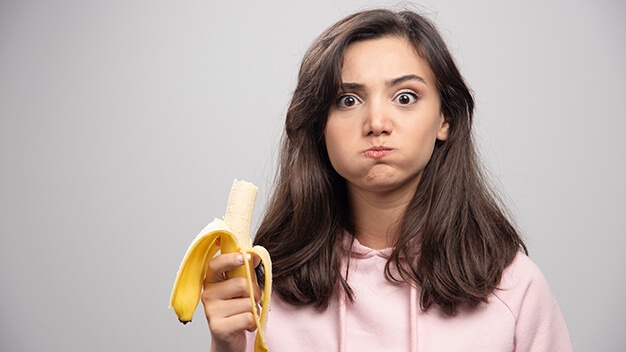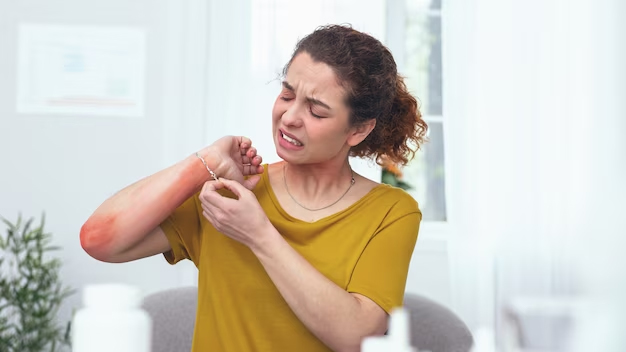On This Page
What is Acne?
Acne is caused by obstruction of hair follicles and results in whiteheads, blackheads, or pimples. It is related to hormone levels, lifestyle, nature of skin, etc. It is also know as Acne Vulgaris. Acne is not only a physical issue but may also affect the psychological and social aspects of an individual.
Ayurveda explains about Mukhadushika which is having the same manifestation of Acne. IAFA Ayurveda® promises effective Ayurvedic management for acne. IAFA Ayurveda® is the ultimate center for revitalizing your skin through Ayurveda.
Causes of Acne
Acne is caused by different reasons. Major reasons of Acne are:
- Bacterial infection
- Excess oil secretion
- Oil and dead skin cells getting clogged in hair follicles
- Excess activity of androgen hormone
- Menstruation
- Corticosteroids
- Pregnancy
- Family History
Hair follicles are directly connected to oil-producing glands. Clogging of hair follicles with oil and other particles results in the formation of acne. Stress, certain medications, carbohydrate-rich diet, etc. increase the risk of affection with acne.
Ayurveda says Acne is caused by reasons that vitiate Kapha and Vata dosha. The reasons are related with food habits, exposure to dust and wind, mental factors, etc.
Symptoms of Acne
Signs and symptoms of acne vary in each individual. It is mainly expressed on the face, forehead, chest, upper back, and shoulder region as these areas have more oil glands. Major manifestations include:
- Whiteheads (closed pores)
- Blackheads (opened pores)
- Small, red bumps which are tender – Papules
- Papules with pus at their tips
- Large and solid painful lumps beneath the skin surface – nodules
- Painful and pus-filled lumps beneath the skin surface – cystic lesions
- Raised red spots with a white center – Pimples.
Ayurveda says acne will be painful, hard, deep seated and also pus filled.
Ayurvedic Reference of Acne Vulgaris
शाल्मलीकण्डकागारपिटका: सरुजोघना: l
मेदोगर्भामुखेयूनांताभ्यांचमुखदूषिका ll
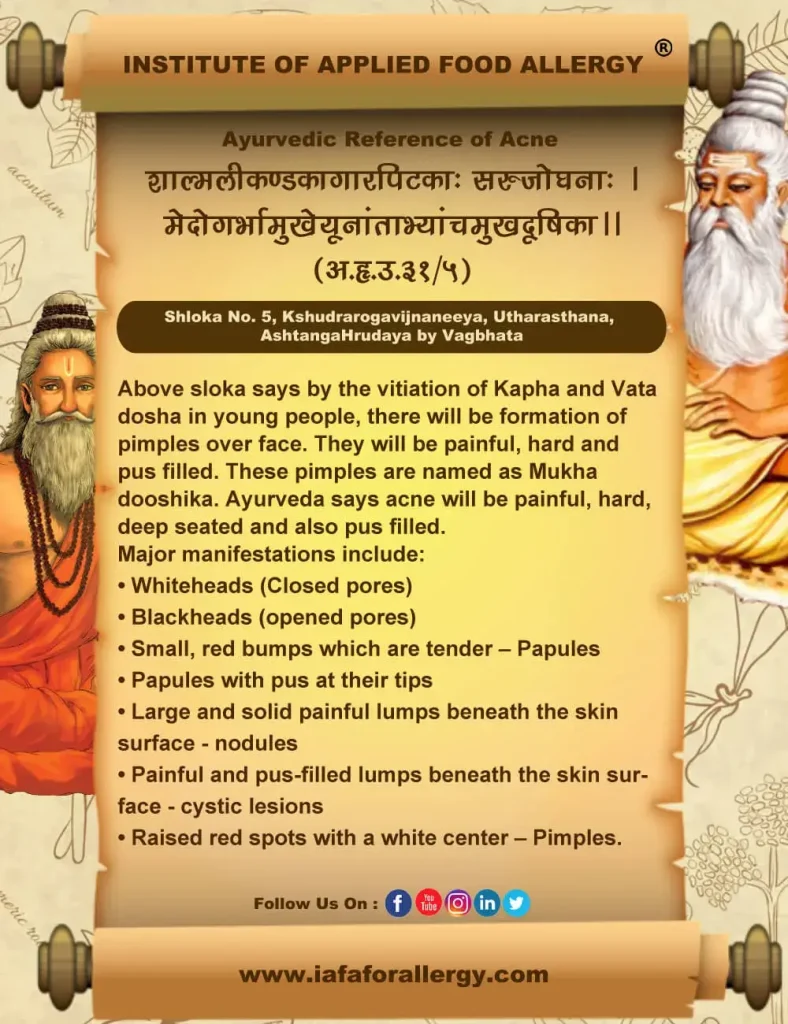
Diagnosis of Acne Vulgaris
Accurate diagnosis of acne vulgaris can be followed by Nidan Panchak in Ayurveda.
Causative Factors of Acne Vulgaris
Aahar (Food Habits)
- Virudha Aahar (wrong food combinations such as fruits with milk, milk with fish, etc.),
- Excessively spicy, salty & sour food, curd, and upvasa (fasting).
Manasik (Psychological)
- Krodh (Anger),
- Stress etc.
Vihara (Physical Activities)
- Ati Vyayam (Excessive Physical Exercise),
- Ati Jagran (Sleeping Late at Night),
- Daytime Sleep after lunch,
- Vegvidharana (Suppression of Nature Urges)
Vaya (Age)
- At Young/ Teen Age.
Predominant Symptoms of Acne Vulgaris
Purvroop in nidan panchak has its own significance because these are symptoms that are produced by the body before the appearance of acne on face. These purvaroop symptoms behave as an alarm to patients and are a very helpful diagnostic tool for an ayurvedic practitioner. Acne Vulgaris if treated at this stage, is easily curable.
- Sparshagyatvama (Loss of Touch Sensation)
- Ati Sweda (Excess Sweat)
- Asweda (No Sweat)
- Vaivarnya (Discoloration of Skin)
- Koth (Appearance of Rash)
- Kandu (Itching)
- Toda (Piercing Pain)
- Shool (Pain),
- Daah (Burning Sensation),
- Rukshta (Dryness),
- Asrijah Krishnta (Reddish Black Discoloration of Skin),
- Kharata (Excess Roughness),
- Saptagata (Numbness).
Signs of Acne Vulgaris (Mukhdushika)
Roop in nidan panchak are the symptoms that are easily identified by an intuitive ayurvedic practitioner to get an accurate differential diagnosis.
- Shalmali Kantakara (just like Thorn of Shalmali)
- Shopha (Swelling)
- Saruja (Pain)
- Ghan (Hard and Thick)
- Medogarbhamukhi (Collection of Fatty Material inside Boil)
- Daha (Burning Pain),
- Kandu (Itching),
- Vedana (Pain),
- Raktima (in Red colour).
Method of Examination
To identify the disease whose manifestation isn’t clear, Upshyay can be used. Upshyay means various examination methods to reach a proper diagnosis.
Stages of Formation of Disease
शाल्मलीकण्टकप्रख्या: कफमारुतरक्तजा:।
युवानपिडकायूनांविज्ञेयामुखदूषिका:॥
माधवनिदानक्षुद्ररोग। ३३
Above Sloka explains that Shalmali Thorn (a plant) like eruption on face caused by Vitiliated Kapha (Life Force), Vata (Life Force) and Rakta (Blood) are known as Mukhdushika harm to the beauty of the face. This causes disruption of the face and often occurs at young age, hence called as Youvanpidika. Mukhdushika is explained under Kshudrarog in Ayurveda.

Have A Health Issue?
Consult Online
– Dr. Sahil Gupta (B.A.M.S., M.H.A.)
Ayurvedic Allergy Specialist
CEO & Founder of IAFA®
At last, Easier Acne Vulgaris Management
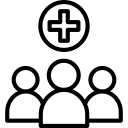
Trusted by
More than 90,000 Patients
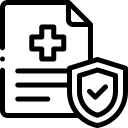
Convenient
at-Home Treatments

9.2 / 10
Customer Satisfaction Score
Ayurvedic Treatment for Acne
Herbs that are useful in Ayurvedic Treatment for Acne include Nimba (Azadirachta indica), Kumari (Aloe vera), Vacha (Acorus calamus), Lodhra (Symplocos racemosa) and Rakta Chandana (Pterocarpus santalinus).
Diet and Lifestyle Guidance
Pathya (Do’s)
- Take light food
- Have lot of fruits and salads
- Drink plenty of water
- Wash face frequently with warm water
- Adequate sleep
- Regular steaming of face till complete sweating
- Daily exercise
- Eat astringent and bitter taste herbs to detoxify the body
Apathya (Don’ts)
- Avoid non-vegetarian food especially egg
- Avoid fried & oily food
- Decrease use of black gram &pappad
- Avoid mayonnaise
- Avoid journey to places with excess dust
- Reduce stress
- Avoid touching on pimples
- Avoid unnecessary make ups and greasy skin products
- Avoid pollution and direct exposure to sunlight
Yoga and Pranayama for Acne
Yoga asanas that are helpful in holistic treatment for Acne include Sukhasana, Uttanasana, Sasangasana, Vajrasana, Halasana and Bhujangasana.
Pranayama is very beneficial to relieve stress, which is a leading reason for acne. It also helps to open up body channels and thus makes the skin to breathe properly.
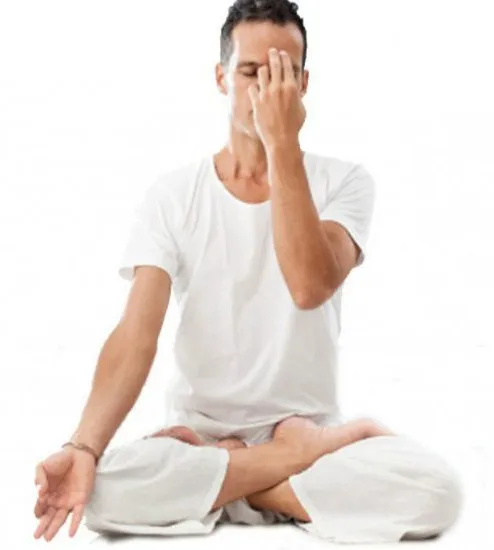
Frequently Asked Questions
Question: What is Acne?
Answer: Acne is a skin problem characterized by whiteheads, blackheads, or pimples due to the clogging of hair follicles with oil and dead cells.
Question: What are the Features of Acne?
Answer: Acne will be characterized in different forms. It may be painful or tender. The pores will be either closed or opened, pus-filled, etc.
Question: How Ayurveda Cures Acne?
Answer: Ayurveda provides internal as well as external medicines to remove the discomfort caused by Acne from the base itself
Question: What is the Scope of Ayurveda Treatment in Acne?
Answer: The patient reached an ayurvedic practitioner after trying more than 100+ herbal home remedies with a ray of hope in Ayurveda, IAFA acne treatment is carefully prescribed based on the characteristics of each individual. Have a look at some of our remedies and the uniqueness of our prescriptions! Start IAFA treatment for acne vulgaris.
Question: How long does Acne last?
Answer: Untreated Acne may last for about 4/5years.
Question: Does Acne create complications?
Answer: Yes, if acne is not treated properly it can create compilations like permanent scar effect, anxiety, depression and reduced self-esteem.
Question: Does cystic acne cure by Ayurveda?
Answer: Yes, Ayurveda cures Cystic Acne with no recurrence of disease again.
Question: Does Acne itch?
Answer: Itching is common in Acne.
Question: At what age teenage Acne stops?
Answer: Usually it stops in early 20s but tends to be worse in people with oily skin.
Question: Do Acne scars fade over time?
Answer: Yes, but some Acne scars can become permanent if untreated.
Question: How effective is Ayurvedic treatment for acne?
Answer: Ayurvedic treatment is the most effective one for acne as it follows a comprehensive approach to treat acne from the root. Along with the herbal treatment, ayurvedic treatment also includes changes in diet and lifestyle.
Question: What is the cause of acne vulgaris according to Ayurveda?
Answer: According to Ayurveda, acne vulgaris is caused due to the vitiation of the doshas which in turn aggravate Rakta Dhatu (blood).
Question: What is the Ayurvedic treatment of acne?
Answer: Ayurveda prescribes blood purifying and detoxifying herbs for the treatment of acne that possess bitter and astringent tastes, cooling and mind soothing herbs as well as hormonal balancing herbs if the cause lies in it.
References
- Gupta A, Upadhyaya Y. Ashtanga Hrudaya, Vagbhata. Varanasi: Chaukhambha Prakashan; 2012. P. 561.
- Sharma PV. Chakradatta Tika. Varanasi: Chaukhambha Prakashan; 2012. P 557-558.
- 9th ed. Varanasi: Chaukhambha Orientalia; 2007. Sushruta Samhita, Nidana Sthana 13/39, Edited by Vaidya Yadavji Trikamji Acharaya.
- Pt. Kashinath Shastri, Dr. Gorakhnath Chaturvedi, Charak Samhita Sutrasthana, 24/16, Chaukhambha Bharti Academy, Varanasi, 2008. P. 445.
- Sahil Gupta, Child Health and Ayurveda, Edition 2021, Acne Chapter No. 11, Page No. 49-52.
IAFA Ayurveda® provides authentic and fruitful Ayurvedic treatment of Acne so that Acne will no longer hurt your beauty and dignity.
Consult with our Ayurvedic Allergy Specialist for real rejuvenation and beauty care!!!
Was this Page Helpful?
So IAFA® Root-Cause Treatment of Your Acne Vulgaris is Just 3 Steps Away!

01. Connect With Us
Share your history of illness or Book your appointment

02. Consult With Us
Dr. Gupta a certified Ayurvedic Allergist Consultant

03. Root Cause Treatment
Get an accurate diagnosis, medicines, diet & lifestyle change
Real Case Studies – Successfully Treated Patients
Real Case Studies of Successfully Treated Patients from All Around the World by IAFA Ayurveda®
-
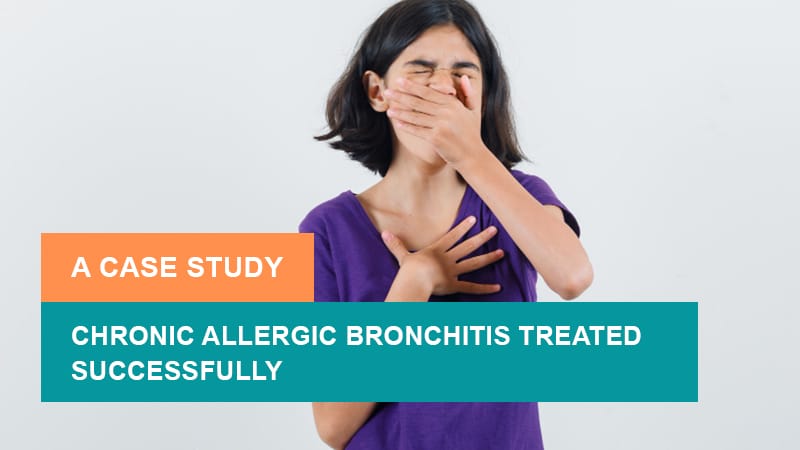
Chronic Allergic Bronchitis Treated Successfully – A Case Study
It is a case study about successful treatment of Chronic Allergic Bronchitis.…
-
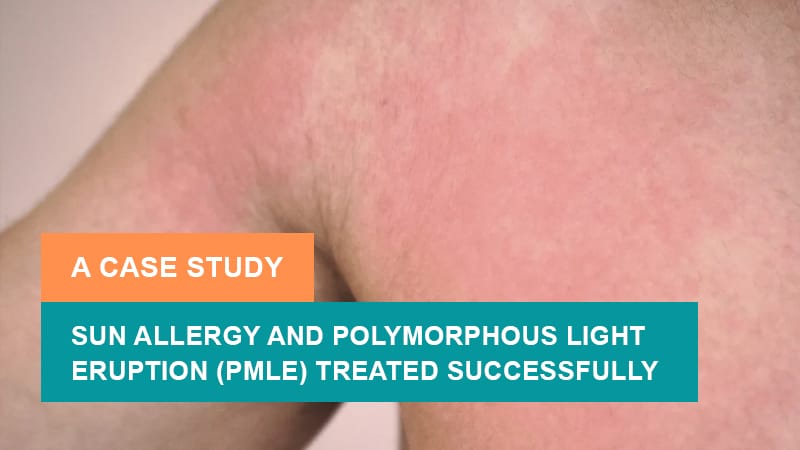
Sun Allergy and Polymorphous Light Eruption (PMLE) Treated Successfully – A Case Study
12 Year old child girl, was suffering from Sun Allergy and Polymorphous…
-

Successful Treatment of Dyshidrotic Eczema and Onychomycosis – A Case Study
It is a case study about successful treatment of Dyshidrotic Eczema and…
-

How Ayurveda Helps to Treat Urticaria With Angioedema Successfully? A Case Study
Learn complete case study about how Ayurveda helps to treat Urticaria With…

